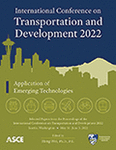Motorcycle Safety Investigation in Kentucky Using Machine and Deep Learning Techniques
Publication: International Conference on Transportation and Development 2022
ABSTRACT
This study analyzes the factors affecting motorcycle crash severity in the state of Kentucky while applying machine learning method (i.e., random forest) and deep learning model (i.e., combined principal component-neural network model). Severe motorcycle crashes were the main severity level outcome analyzed in this study and are those crashes resulting in either serious motorcycle injury or fatality. To the authors’ knowledge, these models have been very rarely implemented to analyze motorcycle crashes, especially when it comes to severe motorcycle crashes. Recent five-year motorcycle crash data (2015 to 2019) from Kentucky were used. The random forest classifier was applied to rank each feature’s importance in influencing serious injury or fatal motorcycle crashes. The random forest classifier indicated that collision time, crash location, driver age, helmet use, and vehicle type colliding with the motorcycle were the key features affecting severe motorcycle crashes while yielding 91% prediction accuracy. By testing multiple numbers of principal components, 800 principal components were found to decrease overfitting while still retaining high prediction accuracy. Thus, 800 principal components were used for fitting the neural network model. The neural network showed that driver-related (i.e., age), crash-related (i.e., crash location, collision time, and manner of motorcycle collision), and roadway-related factors (i.e., roadway surface condition) could successfully predict severe motorcycle crashes with 94.2% prediction accuracy. An advanced occlusion-based interpretation of the neural network model also produced a list of features most highly correlated with the model prediction performance. The neural network model result was largely consistent with that of random forest. Nevertheless, deep learning techniques (e.g., the combined principal component-neural network model) could better predict severe motorcycle crashes with higher accuracy compared to machine learning techniques (e.g., random forest). Overall, the study results demonstrated that both machine learning (random forest) and deep learning (combined principal component-neural network model) techniques can be used successfully in identifying those key features contributing to severe motorcycle crashes.
Get full access to this article
View all available purchase options and get full access to this chapter.
REFERENCES
Abdel-Aty, M., and Haleem, K. (2011). “Analyzing Angle Crashes at Unsignalized Intersections Using Machine Learning Techniques.” Accident Analysis & Prevention, 43(1), 361–470.
Arteaga, C., Paz, A., and Park, J. W. (2020). “Injury Severity on Traffic Crashes: A Text Mining with an Interpretable Machine-Learning Approach.” Safety Science, 132, 104988.
Chang, F., Xu, P., Zhou, H., Lee, J., and Huang, H. (2019). “Identifying Motorcycle High-Risk Traffic Scenarios through Interactive Analysis of Driver Behavior and Traffic Characteristics.” Transportation Research Part F: Traffic Psychology and Behaviour, 62, 844–854.
Das, S., Dutta, A., Dixon, K., Minjares-Kyle, L., and Gillette, G. (2018). “Using Deep Learning in Severity Analysis of at-Fault Motorcycle Rider Crashes.” Transportation Research Record, 2672(34).
Fergus, R. (2013). Visualizing and Understanding Convolutional Networks (last revised Nov. 28, 2013). <https://arxiv.org/abs/1311.2901>(January 19, 2022).
Harb, R., Yan, X., Radwan, E., and Su, X. (2009). “Exploring Precrash Maneuvers Using Classification Trees and Random Forests.” Accident Analysis & Prevention, 41(1), 98–107.
Islam, M. (2021). “The Effect of Motorcyclists’ Age on Injury Severities in Single-Motorcycle Crashes with Unobserved Heterogeneity.” Journal of Safety Research, 77, 125–138.
Kentucky State Police Web Portal. <https://crashinformationky.org>(August 22, 2021).
Kwayu, K., Kwigizile, V., Lee, K., and Oh, J.-S. (2021). “Discovering Latent Themes in Traffic Fatal Crash Narratives Using Text Mining Analytics and Network Topology.” Accident Analysis & Prevention, 150, 105899.
NHTSA (National Highway Traffic Safety Administration). Traffic Safety Facts 2019. <https://crashstats.nhtsa.dot.gov/Api/Public/ViewPublication/813141>(August 22, 2021).
Rezapour, M., Farid, A., Nazneen, S., and Ksaibati, K. (2021). “Using Machine Learning Techniques for Evaluation of Motorcycle Injury Severity.” IATSS Research, 45(3), 277–285.
Rezapour, M., Molan, A., and Ksaibati, K. (2020). “Analyzing Injury Severity of Motorcycle at-Fault Crashes Using Machine Learning Techniques, Decision Tree and Logistic Regression Models.” International Journal of Transportation Science and Technology, 9(2), 89–99.
Robbins, C., and Fotios, S. (2020). “Motorcycle Safety after-Dark: The Factors Associated with Greater Risk of Road-Traffic Collisions.” Accident Analysis & Prevention, 146, 105731.
Tamakloe, R., Das, S., Aidoo, E., and Park, D. (2022). “Factors Affecting Motorcycle Crash Casualty Severity at Signalized and Non-Signalized Intersections in Ghana: Insights from a Data Mining and Binary Logit Regression Approach.” Accident Analysis & Prevention, 165, 106517.
Information & Authors
Information
Published In
History
Published online: Aug 31, 2022
Authors
Metrics & Citations
Metrics
Citations
Download citation
If you have the appropriate software installed, you can download article citation data to the citation manager of your choice. Simply select your manager software from the list below and click Download.
